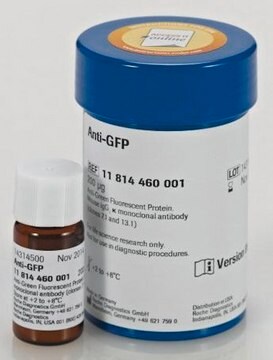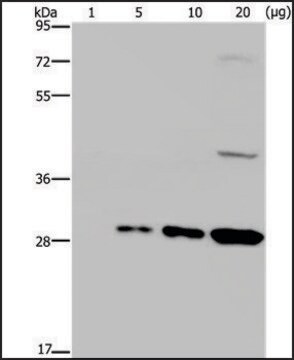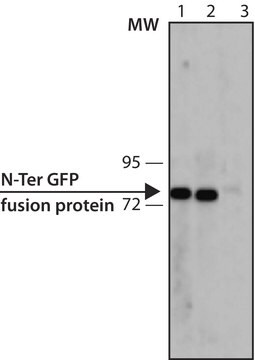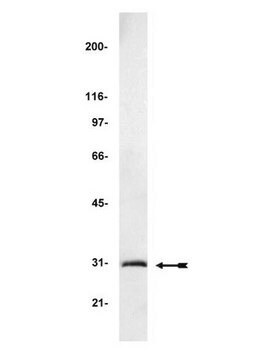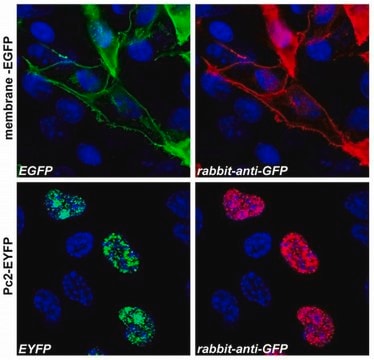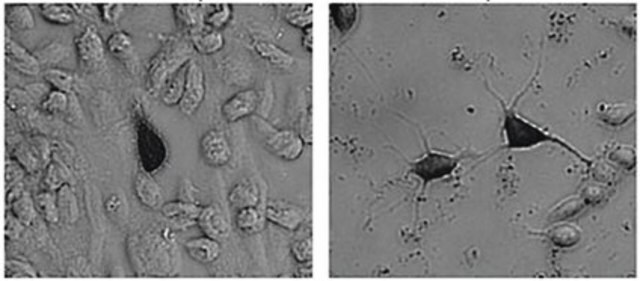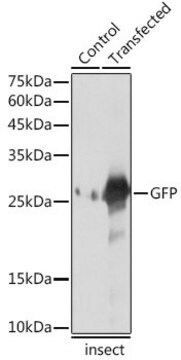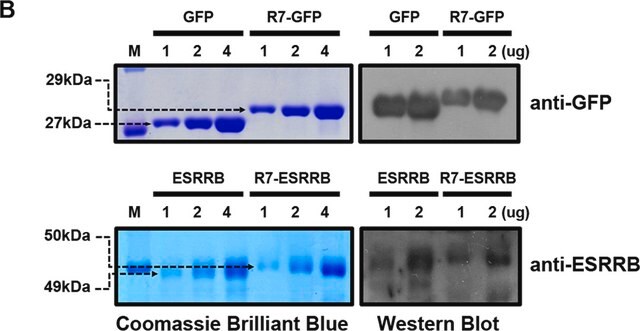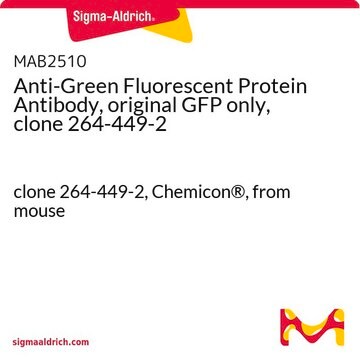Recommended Products
biological source
rabbit
Quality Level
antibody form
affinity purified immunoglobulin
antibody product type
primary antibodies
clone
polyclonal
purified by
affinity chromatography
species reactivity (predicted by homology)
all
manufacturer/tradename
Chemicon®
technique(s)
western blot: suitable
GenBank accession no.
UniProt accession no.
shipped in
wet ice
target post-translational modification
unmodified
Specificity
The antibody reacts with the 28 kDa GFP protein.
Immunogen
Synthetic peptide corresponding to the full length of GFP protein.
Application
Research Category
Epitope Tags & General Use
Epitope Tags & General Use
Research Sub Category
Epitope Tags
Epitope Tags
This Anti-GFP Antibody is validated for use in WB for the detection of GFP.
Western blot: 0.1 μg/mL on GFP recombinant protein.
Optimal working dilutions must be determined by the end user.
Optimal working dilutions must be determined by the end user.
Target description
28 kDa
Physical form
Antigen Affinity Purified
Purified rabbit immunoglobulin in buffer containing PBS containing 0.05% sodium azide.
Storage and Stability
Maintain at 2-8°C in undiluted aliquots for up to 1 year after date of receipt. Avoid repeated freeze/thaw cycles, which may damage IgG and affect product performance.
Legal Information
CHEMICON is a registered trademark of Merck KGaA, Darmstadt, Germany
GenBank is a registered trademark of United States Department of Health and Human Services
Disclaimer
Unless otherwise stated in our catalog or other company documentation accompanying the product(s), our products are intended for research use only and are not to be used for any other purpose, which includes but is not limited to, unauthorized commercial uses, in vitro diagnostic uses, ex vivo or in vivo therapeutic uses or any type of consumption or application to humans or animals.
Not finding the right product?
Try our Product Selector Tool.
Storage Class Code
12 - Non Combustible Liquids
WGK
WGK 1
Flash Point(F)
Not applicable
Flash Point(C)
Not applicable
Certificates of Analysis (COA)
Search for Certificates of Analysis (COA) by entering the products Lot/Batch Number. Lot and Batch Numbers can be found on a product’s label following the words ‘Lot’ or ‘Batch’.
Already Own This Product?
Find documentation for the products that you have recently purchased in the Document Library.
Customers Also Viewed
Cyp1B1 expression promotes angiogenesis by suppressing NF-?B activity.
Palenski, Tammy L, et al.
American Journal of Physiology. Cell Physiology, 305, C1170-C1184 (2013)
Hongliang Zhang et al.
Nature communications, 13(1), 4009-4009 (2022-07-12)
Diphthamide, a post-translationally modified histidine residue of eukaryotic TRANSLATION ELONGATION FACTOR2 (eEF2), is the human host cell-sensitizing target of diphtheria toxin. Diphthamide biosynthesis depends on the 4Fe-4S-cluster protein Dph1 catalyzing the first committed step, as well as Dph2 to Dph7
Tamás Wilheim et al.
Brain structure & function, 226(7), 2387-2399 (2021-07-16)
The endocannabinoids have been shown to target the afferents of hypothalamic neurons via cannabinoid 1 receptor (CB1) and thereby to influence their excitability at various physiological and/or pathological processes. Kisspeptin (KP) neurons form afferents of multiple neuroendocrine cells and influence
Gabriele G Schiattarella et al.
Nature communications, 12(1), 1684-1684 (2021-03-18)
Heart failure with preserved ejection fraction (HFpEF) is now the dominant form of heart failure and one for which no efficacious therapies exist. Obesity and lipid mishandling greatly contribute to HFpEF. However, molecular mechanism(s) governing metabolic alterations and perturbations in
Bettina Rieger et al.
EMBO reports, 22(12), e52727-e52727 (2021-10-02)
The classical view of oxidative phosphorylation is that a proton motive force (PMF) generated by the respiratory chain complexes fuels ATP synthesis via ATP synthase. Yet, under glycolytic conditions, ATP synthase in its reverse mode also can contribute to the
Our team of scientists has experience in all areas of research including Life Science, Material Science, Chemical Synthesis, Chromatography, Analytical and many others.
Contact Technical Service